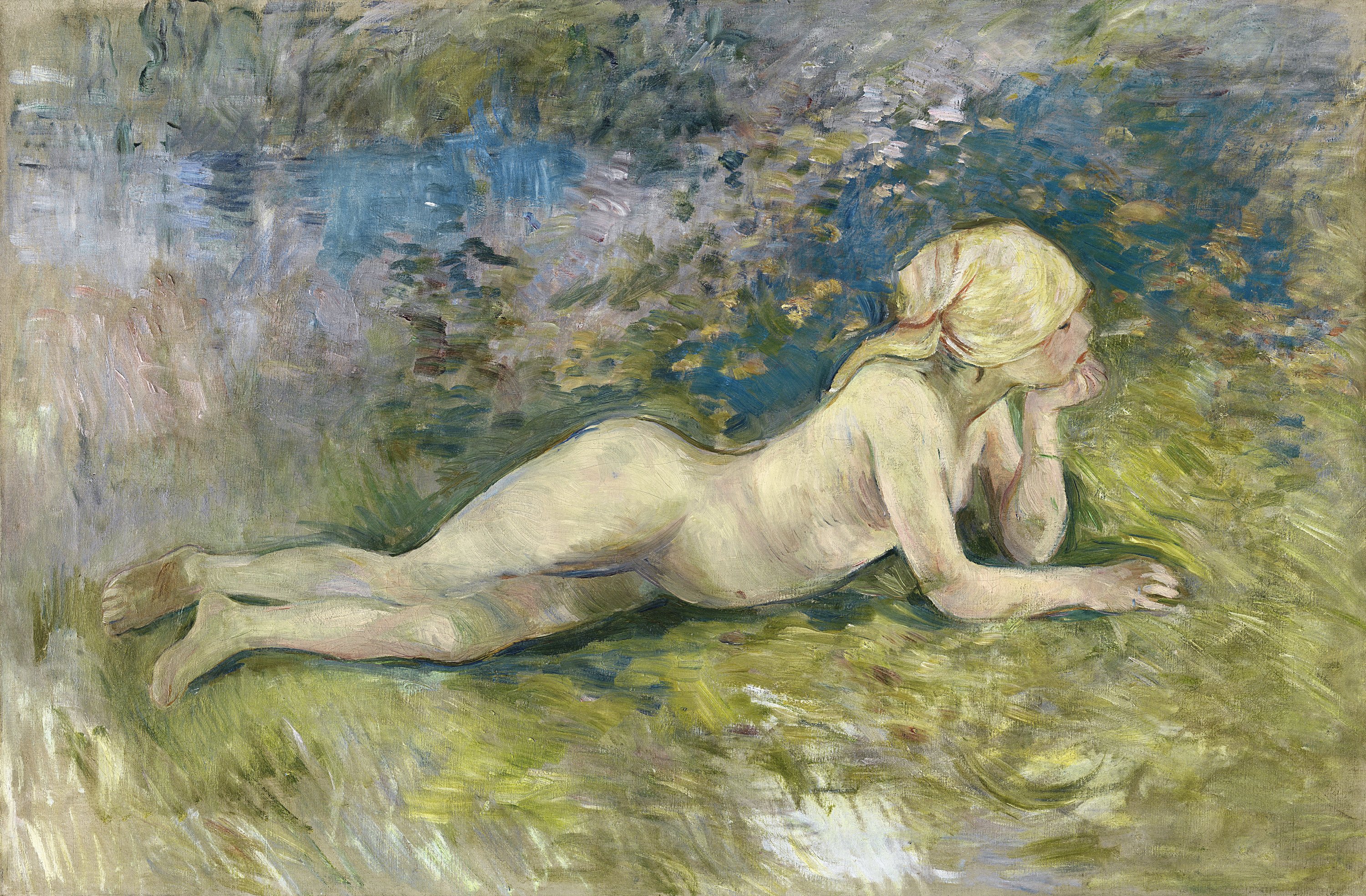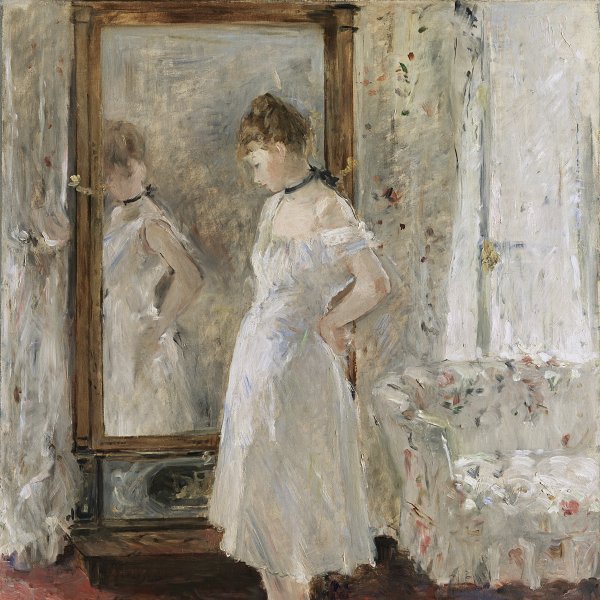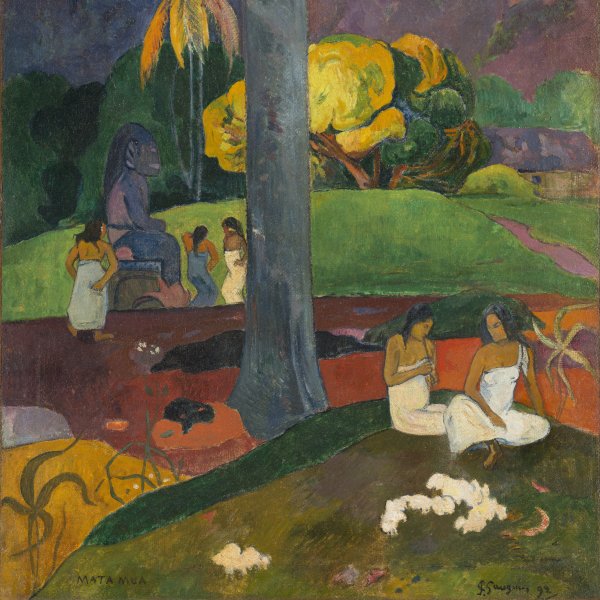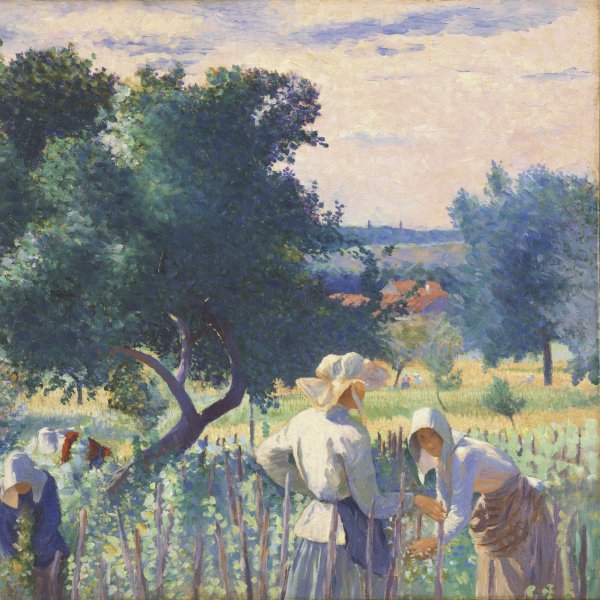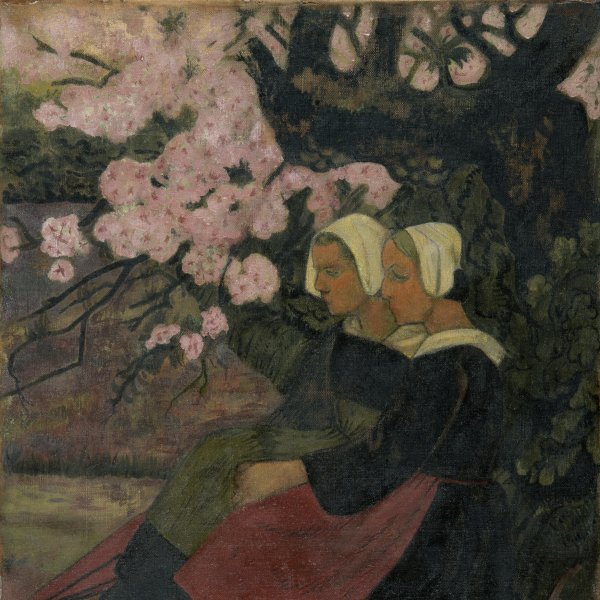Reclining Nude Shepherdess
1891
Oil on canvas.
57.5 x 86.4 cm
Carmen Thyssen Collection
Inv. no. (
CTB.2000.9
)
Not on display
Level 2
Permanent Collection
Level 1
Permanent Collection
Level 0
Carmen Thyssen Collection and Temporary exhibition rooms
Level -1
Temporary exhibition rooms, Conference room and EducaThyssen workshop
In the spring and summer of 1890 -and again in 1891- Berthe Morisot, with her husband Eugène Manet and her daughter Julie, rented a house called «La maison Blotière» at Mézy-sur-Seine, near Meulan, some fifty kilometres west of Paris. The house had an orchard and a terrace that overlooked the Seine. Morisot painted a few landscapes showing this view. The unspoilt rustic quality of the setting tempted her to try new subject-matter. In particular, she worked extensively on what became her largest and most ambitious composition, two young girls (one of them Julie) picking cherries (Cherry Tree, 1891, Neuilly-sur-Seine, estate of Mr and Mrs Denis Rouart). But she also made several drawings and three different painted versions of a composition showing a young shepherdess reclining in the grass with a goat by her side. A young girl of the village named Gabrièlle Dufous willingly acted as model for the shepherdess (as well as for other works).
Morisot proceeded in time-honoured academic fashion in evolving the final composition. She painted the landscape background (The Seine Valley at Mézy, 1891, La Jolla, Mr and Mrs Norton S. Walbridge); she painted the goat (The Goat Colette, 1891, sale London, 1 December 1971, lot 16); she made a rapidly executed compositional sketch with the reclining shepherdess, her goat, and the view of the Seine in the background (Reclining Shepherdess, 1891, Sale Paris, Galerie Daniel Malingue). Above all, in order to clarify the pose of the reclining shepherdess, she posed the model in the nude, allowing her, however, to retain her head-dress. Such is the Carmen Thyssen-Bornemisza painting. The contours and modelling of the young girl's body are realised in a more contained and compact style than would have been the case in Morisot's Impressionist painting of the late 1870s and early 1880s. By 1891, she had come to admire greatly Renoir's treatment of the female nude, first fully announced in The Large Bathers 1885-1887, Philadelphia (PA), Philadelphia Museum of Art. And, interestingly, Renoir visited her at Mézy-sur-Seine during her stays there in 1890 and 1891. Like Renoir at this period, she made preliminary drawings, some of them in her small sketchbook. The final painting, a large work of 64 x 116 cm, concentrates attention on the reclining figure by eliminating sky and distant landscape.
This study of the nude nonetheless shows Morisot achieving her own distinctive pose that has no parallel in Renoir's oeuvre -nor in that of Degas, whose nudes she also greatly admired. In fact, the notion of placing a young female nude in an outdoor setting echoes several of Corot's compositions of the 1860s- and the young Berthe Morisot was a pupil of Corot. For her part, this is the most complete and most ambitious study of the female nude that she ever painted. And only one other nude study exists from this last period of her career, where she used the twelve-year old Gabrièlle Dufous in a pastoral idyll, showing the model seated in profile by the bank of a stream. In the Carmen Thyssen-Bornemisza painting, the nude loses her shepherdess connotation (even though she retains her headscarf) and becomes a nymph or «source» caught in quiet contemplation by a stretch of water.
Ronald Pickvance
Morisot proceeded in time-honoured academic fashion in evolving the final composition. She painted the landscape background (The Seine Valley at Mézy, 1891, La Jolla, Mr and Mrs Norton S. Walbridge); she painted the goat (The Goat Colette, 1891, sale London, 1 December 1971, lot 16); she made a rapidly executed compositional sketch with the reclining shepherdess, her goat, and the view of the Seine in the background (Reclining Shepherdess, 1891, Sale Paris, Galerie Daniel Malingue). Above all, in order to clarify the pose of the reclining shepherdess, she posed the model in the nude, allowing her, however, to retain her head-dress. Such is the Carmen Thyssen-Bornemisza painting. The contours and modelling of the young girl's body are realised in a more contained and compact style than would have been the case in Morisot's Impressionist painting of the late 1870s and early 1880s. By 1891, she had come to admire greatly Renoir's treatment of the female nude, first fully announced in The Large Bathers 1885-1887, Philadelphia (PA), Philadelphia Museum of Art. And, interestingly, Renoir visited her at Mézy-sur-Seine during her stays there in 1890 and 1891. Like Renoir at this period, she made preliminary drawings, some of them in her small sketchbook. The final painting, a large work of 64 x 116 cm, concentrates attention on the reclining figure by eliminating sky and distant landscape.
This study of the nude nonetheless shows Morisot achieving her own distinctive pose that has no parallel in Renoir's oeuvre -nor in that of Degas, whose nudes she also greatly admired. In fact, the notion of placing a young female nude in an outdoor setting echoes several of Corot's compositions of the 1860s- and the young Berthe Morisot was a pupil of Corot. For her part, this is the most complete and most ambitious study of the female nude that she ever painted. And only one other nude study exists from this last period of her career, where she used the twelve-year old Gabrièlle Dufous in a pastoral idyll, showing the model seated in profile by the bank of a stream. In the Carmen Thyssen-Bornemisza painting, the nude loses her shepherdess connotation (even though she retains her headscarf) and becomes a nymph or «source» caught in quiet contemplation by a stretch of water.
Ronald Pickvance
Emotions through art
This artwork is part of a study we conducted to analyze people's emotional responses when observing 125 pieces from the museum.
Joy: 30.23%
Disgust: 0.61%
Contempt: 3.01%
Anger: 6.43%
Fear: 2.35%
Surprise: 2.29%
Sadness: 55.07%

